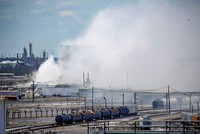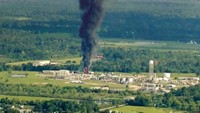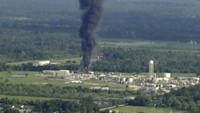Advertisement
Grab your lab coat. Let's get started
Welcome!
Welcome!
Create an account below to get 6 C&EN articles per month, receive newsletters and more - all free.
It seems this is your first time logging in online. Please enter the following information to continue.
As an ACS member you automatically get access to this site. All we need is few more details to create your reading experience.
Not you? Sign in with a different account.
Not you? Sign in with a different account.
ERROR 1
ERROR 1
ERROR 2
ERROR 2
ERROR 2
ERROR 2
ERROR 2
Password and Confirm password must match.
If you have an ACS member number, please enter it here so we can link this account to your membership. (optional)
ERROR 2
ACS values your privacy. By submitting your information, you are gaining access to C&EN and subscribing to our weekly newsletter. We use the information you provide to make your reading experience better, and we will never sell your data to third party members.
Industrial Safety
Bracing for climate change, the chemical industry learns from Hurricane Harvey
Preparations for storms include an emphasis on worker recovery
by Alexander H. Tullo
February 10, 2020
| A version of this story appeared in
Volume 98, Issue 6

Credit: Richard Carson/REUTERS/Newscom | In 2017, Hurricane Harvey dumped over 150 cm of rain on the Houston area, inundating the city and the surrounding region.
On Aug. 25, 2017, with Hurricane Harvey bearing down on the Houston area, Arkema shut down production at its Crosby, Texas, plant and arranged for a “ride-out crew” to triage problems at the facility during the storm.
The plant’s stores of peroxides, which are sensitive to high temperatures, are a vulnerability. They must be stored in warehouses kept as low as –29 °C to prevent them from deteriorating or even combusting.
Because of the weather forecast and their experience with past storms, longtime Arkema workers figured Harvey might bring a half meter of flooding—not enough to cause a major problem. Instead, Harvey dumped more than 150 cm of rain, twice as much as forecasters expected, and inundated the plant with a meter and a half of water.
According to a US Chemical Safety Board (CSB) report, as floodwaters rose, workers shut down power to prevent electrical shorts. They moved the peroxides to refrigerated trailers on higher ground—first using forklifts, and when the waters got too high for that, by hand. The crew then evacuated.
In the subsequent days, the canisters of the peroxides stored in the trailers started to combust. Authorities conducted a controlled burn of the remaining material, and residents within 2 km evacuated. Some 21 people were treated for chemical exposure.
In the face of global warming, which is causing rising seas and more frequent, record-breaking storms, the US chemical industry—historically clustered on the Gulf Coast—is bracing for more events like Harvey and using it as a model for how to better prepare for future storms. The US industry on the Gulf Coast is just one case out of many around the world. Globally, the chemical industry is typically situated much like it is on the US Gulf Coast, near large bodies of water to facilitate logistics. Each region faces its own kinds of storms, and chemical plants on rivers can be choked off by drought and heat waves, like the Rhine was in 2018.
The industry at large fared better in the storm than Arkema did but was still strongly affected, as it has been from other big storms over the years. Harvey temporarily knocked out more than half of US ethylene capacity and 27% of domestic crude oil–refining output, according to the consulting firm IHS Markit.
Analysts say that amid financial pressure caused by such losses, regulation, federal investment in infrastructure, and pressure from insurance companies to improve safety will help the US and global chemical industry become resilient to the increasingly extreme weather events expected with climate change.
After Harvey, the American Chemistry Council (ACC) and the Texas Chemical Council, both trade groups, convened a meeting of executives in Pasadena, Texas, to compare notes about their responses.
Future protection
Source: US Army Corps of Engineers

Overall, according to the ACC, the industry was satisfied with how well its plants held up. One feature of the industry’s reaction to Harvey was its emphasis on employees and local communities. Some 300,000 structures were inundated by Harvey’s flooding, many of them plant workers’ homes. Companies are realizing that in a hurricane, food and blankets can be as critical as concrete and steel.
“The issue really became, ‘How do we take care of our employees and the damage that they had at their homes, such that they can start getting back to a normal life, or at least have a place where they could put their heads down at night and sleep and get their families together, and come back to work and run our facilities?’ ” says Rich Wells, Dow’s vice president of operations for the US Gulf Coast.
Dow’s massive flagship plant in Freeport, Texas, right on the Gulf Coast, didn’t sustain a direct hit from the storm and actually continued running throughout. But area flooding made it impossible to get in and out of Freeport, effectively turning it into an island.
The local airport remained open after the storm. Dow corporate airplanes flew up to San Antonio to pick up food, toiletries, and other supplies. A Dow high-water vehicle brought the materials into town for distribution to workers and the local community. The company also delivered supplies by helicopter to workers stranded at a pipeline control room in Houston.
Dow found rentals and hotel rooms for workers. The company even purchased 200 trailers. Additionally, Dow mustered a crew of employees to help affected colleagues clean up their homes and tear out soaked drywall.
Rod Herrick, who was plant manager for Covestro’s large chemical complex in Baytown, Texas, during Harvey and is now senior vice president and venture manager, says the site—which was carefully planned to be hurricane robust when it was built in the early 1970s—hasn’t suffered major impacts from storms. “Preparing for hurricane season is a planned event at Covestro that is done every year,” he says. “The plan has evolved over the years and will continue to evolve in the future.
“Every hurricane is different, but one item we learned is that if you take care of your people before, during, and after a hurricane, you will have dedicated employees who will have increased loyalty to the company,” Herrick says.
During Harvey, the company sent volunteers to assist its most-affected workers. Meanwhile, a team at the company’s headquarters in Pittsburgh sent down essentials such as toiletries, mops, brooms, and even fuel.
After the storm, Herrick spearheaded an initiative of plant managers in the Baytown area to compile a document outlining best practices for hurricane preparedness.
Other sources paint a less rosy picture of the fallout of the storm and point out that the chemical industry—like other major institutions, including universities—needs to upgrade its disaster preparedness plans to take into account extreme storms that are becoming more frequent.
The CSB’s 2018 report on what happened at the Arkema plant says that the company was prepared for a once-every-100-year storm but not one on the unprecedented scale of Harvey. “None of Arkema’s safeguards used to address electrical power failure met company or industry standards for analyzing independent protection layers for Harvey-level flooding,” it says.
The CSB report adds that “other companies also might be unaware of the potential for flood risks to create process safety hazards at their facilities.”
Arkema is facing civil suits and even criminal charges resulting from the incident. In 2018, the Harris County district attorney filed charges against the company; Richard Rowe, the CEO of its North American operations; and the Crosby plant manager for the chemical release. The DA added charges last year for injuries to two deputies.
Walter D. James III, a Dallas area–based environmental attorney, doesn’t believe the criminal charges themselves will force chemical companies to improve their safety practices. That Arkema hasn’t faced charges from the US Environmental Protection Agency he takes as a sign that the case might be a “one off.”
But James says insurers will likely beef up their requirements for chemical plants, for example, by requiring taller dikes. “The insurance industry is going to drive any changes on the plant level,” he says.
Area universities also go through extensive hurricane planning. Rice University, situated on relatively high ground on the western part of Houston, was barely affected by Harvey, according to Kathryn Cavender, the school’s director of environmental health and safety.
That is largely because Rice had a transformational storm in 2001, when Tropical Storm Allison dumped 100 cm of rain on the area, flooding the campus. After the storm, Rice raised the level of air intakes, built retaining walls around them, installed flood gates, and moved electrical equipment out of basements.
“We made sure all of our chemical buildings now have emergency generators,” Cavender says. “Hundreds of thousands of dollars of research could be ruined if a freezer went out.”
A massive Army Corps of Engineers infrastructure project on the US Gulf Coast might bring relief to the entire region. The Coastal Texas Protection and Restoration Study outlines a plan—costing $23 billion–$32 billion—that would be the largest project the corps has ever undertaken.
According to Kelly Burks-Copes, senior project manager at the Army Corps, during severe storms, water surges from the Gulf of Mexico into Galveston Bay, the harbor behind Galveston Island and Bolivar Peninsula. From there, it funnels into the Houston Ship Channel, where many chemical plants are huddled, and causes flooding.
“The study is not necessarily focused on reducing the risks to the plants themselves but to the communities surrounding the plants that aren’t fortified,” Burks-Copes says.
At the heart of the plan is a 3 km system of gates across the Galveston Harbor Entrance Channel, the inlet into Galveston Bay. The gates would be closed during storms. The largest of these would be nearly 300 m wide to let large ship traffic through and would cost about $6 billion.
The project would also include fortifications to levees and seawalls across Galveston Island and the Bolivar Peninsula, a ring system to protect Galveston Island, and other infrastructure and environmental improvements to the coast.
Burks-Copes says the system should cut the height of storm surges in half. She and chemical executives who are supportive of such projects liken them to the dike-and-floodgate system that protects the Netherlands.
But she notes the system needs more studies, impact statements, and approvals, including one from Congress. Even under the best of circumstances, construction wouldn’t be complete until 2035.
Chemical companies, whether on the Gulf Coast or in the rest of the world, shouldn’t shelve their disaster preparedness plans anytime soon.





Join the conversation
Contact the reporter
Submit a Letter to the Editor for publication
Engage with us on Twitter